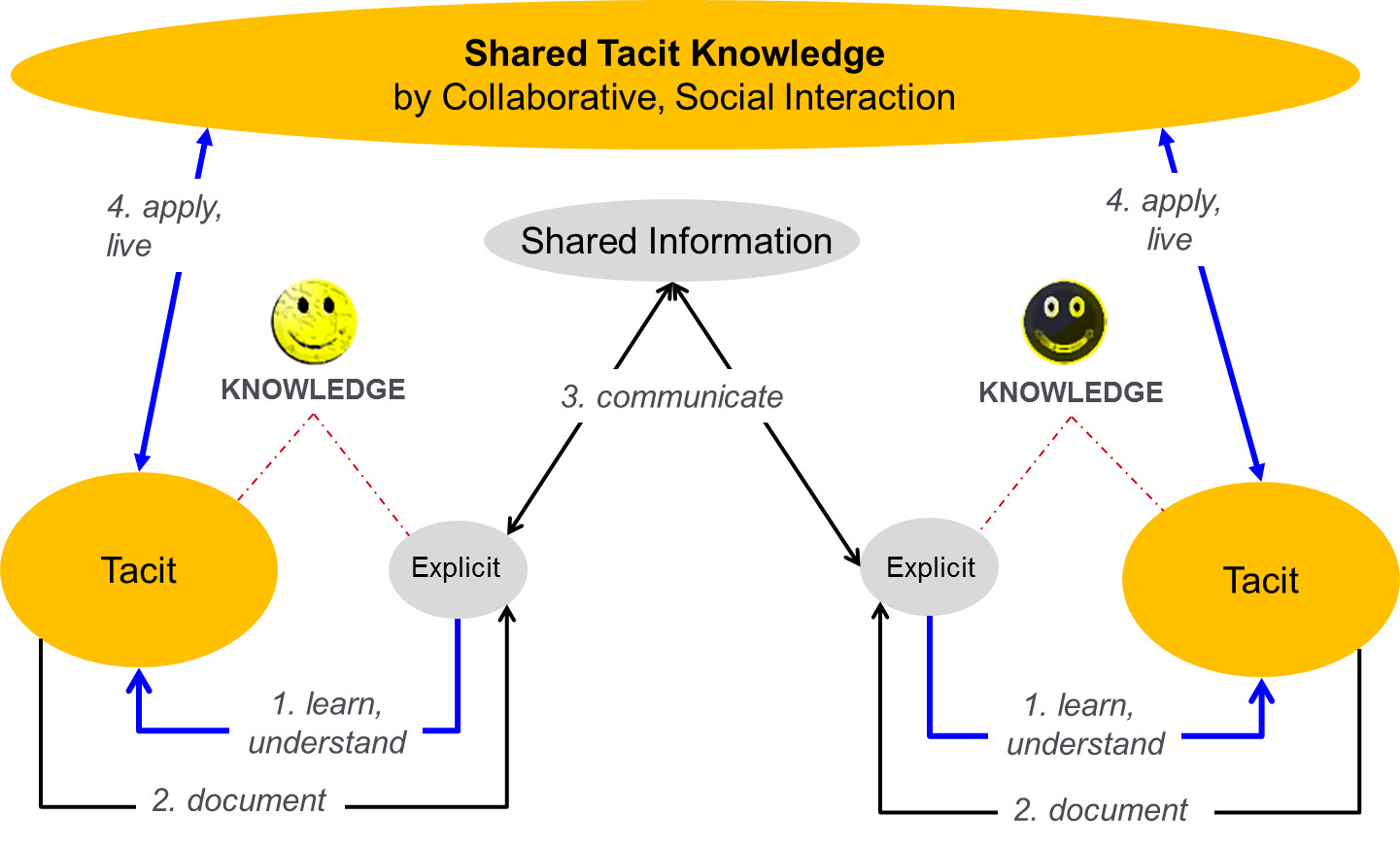In the context of our mission of promoting collaboration at FFHS, my team has developed a variation of the SECI model of knowledge conversion (Nonaka & Takeuchi 1995) in which we focus on the foundations of knowledge sharing and which, for this reason, is called “Basic Knowledge Sharing Model”.
Both models are based on the distinction of two kinds or dimensions of knowledge: a) explicit knowledge, b) tacit knowledge. Explicit knowledge is knowledge that one could easily express or which is already expressed (by spoken words, written in documents or by other means that make it perceivable). But this is not the whole knowledge base. As Polanyi wrote: “one can know more than one can tell” (Polanyi 1966, p. 8) and this “more” is a second kind or dimension of knowledge called “tacit” knowledge, the knowledge that one cannot easily express and that has not been expressed (because we are not able to do it, because it would take too much time, etc. ); notice that this is the larger part - maybe 80% or even more - of our knowledge base: in fact, we are much faster in thinking and doing than in speaking and writing! Compare for example riding a bicycle with a spoken or written description of how to ride it. Metaphorically we could also say that explicit knowledge is only the shadow of tacit knowledge.

Figure 1. Basic Knowledge Sharing Model - IECS
Differently from the SECI model, in our knowledge sharing model we begin by explicitly considering two individuals, each with her knowledge base, and look at how knowledge conversions proceed first within the two persons and then between them. As a consequence we start within the individual (Fig. 1):
- by considering first the knowledge conversion from explicit to tacit, called “internalization” (1. to learn, to understand);
- then we consider as second the reverse knowledge conversion, from tacit to explicit, called “externalization” (2. to document).
- In a third step we look at the knowledge conversion from explicit to explicit called “combination”, which in our case is seen as communication in the sense of an exchange of information (3. communicate) between two individuals;
- finally we come to the crucial, fourth step called “socialization” in which tacit knowledge is shared between the two individuals by means of interactions (4. apply, live).
Thus the sequence of our model is 1. Internalization >>> 2. Externalization >>> 3. Combination >>> 4. Socialization, or abbreviated IECS by using the initials of these steps, like in SECI.
Regarding socialization and collaboration it is important to notice that in these interactions tacit knowledge “is commonly and easily conveyed by narrative, although narrative exemplifies rather than exhaustively describes such knowledge” (Linde 2001). Other practical ways to share tacit knowledge are listed by Von Krogh et al. (2000:83): direct observation and narration, imitation, experimentation and comparison, joint execution. They also mention conversations as an enabler of tacit knowledge sharing (2000:125ff) and suggest that tacit knowledge can be seen as the clay that participants of knowledge-creating conversations work with and form eventually arriving at new concepts (Von Krogh et al.: 135).
References
Bettoni, M., Bernhard, W., Bittel, N. & Mirata, V. (in press) Sharing Tacit Knowledge in Meetings: The OSG Approach. Paper presented at the 20th Knowledge Management Forum, Milan, 28 October 2015. In press: kappaemme 26, Speciale KM 2015, Pavia: Jekpot.
Linde, C. (2001) Narrative and Social Tacit Knowledge. Journal of Knowledge Management, Special Issue on Tacit Knowledge Exchange and Active Learning, 5 (2)
Nonaka, I. & Takeuchi, H. (1995) The knowledge creating company: how Japanese companies create the dynamics of innovation, New York: Oxford University Press.
Polanyi, M. (1966) The Tacit Dimension, Gloucester (Mass.): Peter Smith
Von Krogh, G., Ichijo, K. & Nonaka, I. (2000) Enabling Knowledge Creation. Oxford: Oxford University Press.